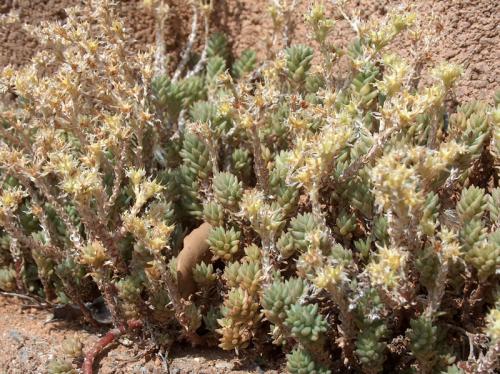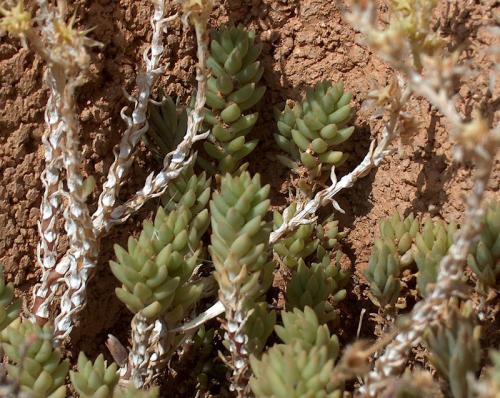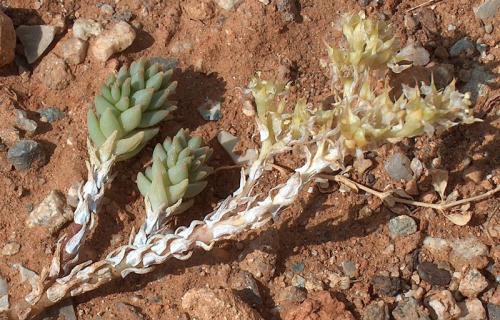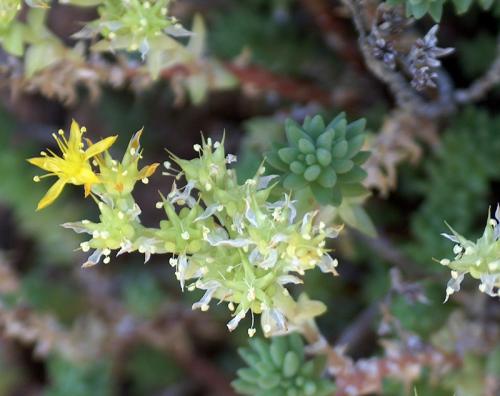URVILLEI De Candolle, 1828
Synonyms :
Sedum acre var. hirsutum Wierzbicki (s.a.)
Sedum hillebrandtii Fenzl (1856) / Sedum urvillei ssp. hillebrandtii (Fenzl) D. A. Webb (s.a.) / Sedum sexangulare ssp. hillebrandtii (Fenzl) Nyman (1890) / Sedum sartorianum ssp. hillebrandtii (Fenzl) D. A. Webb (1963)
Sedum sartorianum Boissier (1856) / Sedum acre ssp. sartorianum (Boissier) J. A. Huber (1936) / Sedum urvillei ssp. sartorianum (Boissier) Byalt (1997)
Sedum ponticum Velenovsky (1891) / Sedum acre var. ponticum (Velenovsky) Stojanov & Stefanoff (s.a.) / Sedum sartorianum ssp. ponticum (Velenovsky) D. A. Webb (1963)
Sedum stribrnyi Velenovsky (1892) / Sedum acre var. stribrnyi ( Velenovsky) Stojanov & Stefanoff (s.a.) / Sedum sexangulare ssp. stribrnyi (Velenovsky) Fröderström (1932) / Sedum sartorianum ssp. stribrnyi (Velenovsky) D. A. Webb (1963)
Sedum novakii Domin (1929)
Distribution : From Hungary (Danube Basin) throughout the Balkans to Greece and Turkey (central and southern Anatolia), also Ukraine (Crimea) ; on rock ledges and in pockets, rocky slopes and stony meadows, on limestone, 800 - 2450 m.
Description (according to IHSP, 2003) :
Perennial herbs, often with ascending or erect much-branched non-flowering shoots, rooting at the base, forming tufts or mats, with the lower stem parts clothed with rather coriaceous dead leaves, lateral branches easily detaching.
Leaves alternate, densely imbricate, conical to linear-oblong, subacute, with a large broad truncate spur, ± 8 mm, dull, dark green or glaucous, dead leaves persistent, basal 1/2 white, but black or grey towards the tip.
Inflorescences : Flowering branches stems 5 - 20 cm, erect or ascending, inflorescences cymes with 2 (-4) cincinni, these rarely forked, bracts 2 per flower.
FIowers 5-merous, sessile or subsessile, sepals broadly sessile, unequal, lanceolate, subacute, petals lanceolate, acuminate, 5 - 7 mm, yellow, filaments yellow, anthers yellow.
Cytology : 2n = 32, 48, 64, 80, 96, 112, 128
Very variable, but representing an almost continuous series of forms. Of all described segregates, the geographically isolated S. hillebrandtii (Danube Basin) seems to be most distinct. However, formal subdivision of the species appears to be futile as there is otherwise no correlation with either the geographical distribution of the different forms or the cytological variation. The species belongs to the comparium of Ser. Alpestria A. Berger ('t Hart 1991).
Ray Stephenson (Sedum, Cultivated Stonecrops, 1994, pp 102 - 103) :
Gardeners perpetuate the names "Sedum stribrnyi", "S. sartorianum", and "S. hillebrandtii" for they are so well known, and the plants in cultivation bearing these names appear distinct. These once apparently distinct species are all interlinked by intermediate forms in the wild. 't Hart's work (1978) has shown that S. urvillei incorporates them all and therefore is a variable, yet distinct species.
Sedum urvillei has fairly upright shoots, 5 - 12 cm (2 - 5 in) high, imbricately covered with gray-green or reddish, semi-terete leaves, each with a distinct, large, broad, truncate spur. Stems are shaggy with dead, silvery-gray leaves, and the inflorescence is a few-branched, short, compact cyme carrying yellow flowers, which could by the casual observer be taken for those of S. acre.
Habitat : This polymorphic species is wide-spread in the far east of Europe and into the Middle East, from sea level to high mountain zones.
Main points of distinction : Large, broad, truncate spurs (Leaf shapes, fig 1n, o) differentiate this species from any other members of this group except for Sedum borissovae, which has much smaller leaves with very rounded tips and lax cymes of flowers.
Variation : Smaller forms of Sedum urvillei from Bulgaria and northern Greece, once re-ferred to as "S. stribrnyi", tend to be suffused red throughout the summer. Large forms from Greece, once referred to as "S. sartorianum", tend to remain light green throughout the year, and the low, lax form from the Carpathians (i.e., "S. hillebrandtii") has red stems and finer glaucous-green leaves. In Europe, tetraploids (2n = 64) appear to be most common; diploids (2n = 32) and triploids (2n = 48) are also common; hexaploids
(2n = 96), heptaploids (2n = 112), and octoploids (2n = 128) have been found in southern Greece, and pentaploids (2n = 80) in former Yugoslavia, Greece, and Bulgaria. All levels of ploidy, although vegetatively very similar, retain slight differences in cultivation.
Horticulture : Sedum urvillei is much slower than, and certainly not as dense as, S. acre. Plants become brittle in autumn when bits break off easily and root. This is a neat, easily controlled species that in all its forms is useful in raised stone troughs and beds, but is not easy to establish on a wall. Perhaps some protection will be needed in areas with extreme winters. Like S. sexangulare, this species tends to flower quite late in summer.
Plant in cultivation at the Botanical Garden of Nice, France / Plante en culture au jardin botanique de la ville de Nice (France)



